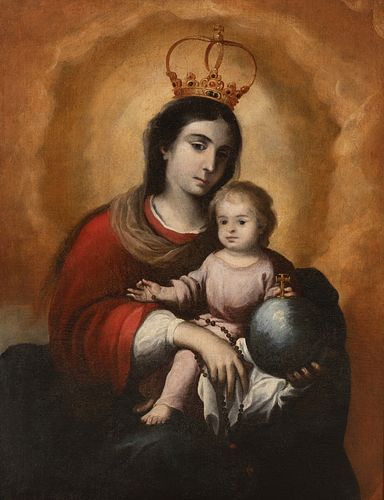Spanish school of the XVI century. Circle of FRANCISCO DE ZURBARÁN (Fuente de Cantos, Badajoz, 1598 - Madrid, 1664). "Virgin with child Salvator Mund
Lot 62
About Seller
Setdart Auction House
Carrer Aragó 346
Barcelona
Spain
Setdart Subastas was born in 2004 and is currently the first online art auction in Spain with solidity, prestige and reliability guaranteed by our more than 60,000 users. Setdart has a young, dynamic and enterprising team ready to successfully manage the purchase and sale of art works through custom...Read more
Estimate:
EUR€12,000 - EUR€13,000
$12,903.23 - $13,978.49
Absentee vs Live bid
Two ways to bid:
- Leave a max absentee bid and the platform will bid on your behalf up to your maximum bid during the live auction.
- Bid live during the auction and your bids will be submitted real-time to the auctioneer.
Bid Increments
| Price | Bid Increment |
|---|---|
| EUR€0 | EUR€10 |
| EUR€200 | EUR€25 |
| EUR€500 | EUR€50 |
| EUR€1,000 | EUR€100 |
| EUR€3,000 | EUR€200 |
| EUR€5,000 | EUR€500 |
| EUR€10,000 | EUR€1,000 |
| EUR€20,000 | EUR€2,000 |
| EUR€50,000 | EUR€5,000 |
About Auction
By Setdart Auction House
Nov 3, 2021
Set Reminder
2021-11-03 08:00:00
2021-11-03 08:00:00
America/New_York
Bidsquare
Bidsquare : OLD MASTERS
https://www.bidsquare.com/auctions/setdart-auction-house/old-masters-7786
Setdart Auction House sofia@setdart.com
Setdart Auction House sofia@setdart.com
- Lot Description
Spanish school of the XVI century. Circle of FRANCISCO DE ZURBARÁN (Fuente de Cantos, Badajoz, 1598 - Madrid, 1664). "Virgin with child Salvator Mundi". Oil on canvas. Relined at the end of the XVIII century. Measurements: 111 x 85 cm; 120 x 93 cm (frame). The wake of the Marian painting of Zurbarán is manifested in this work of Christ as "Salvator Mundi", an iconography that represents the Christological concept of Jesus Christ as universal savior, in relation to his role as judge in the Final Judgment and his character of Redeemer. The monumental canon of the Virgin and child, their sculptural presence, has been achieved through subtle light modeling. The melancholic tenderness of the faces and the way in which the figures emerge emphatically from a misty background show the influence of Zurbarán. Francisco de Zurbarán trained in Seville, where he was a disciple of Pedro Díaz de Villanueva between 1614 and 1617. During this period he would have the opportunity to meet Pachecho and Herrera, and to establish contacts with his contemporaries Velázquez and Cano, apprentices like him in Seville at the time. After several years of diverse apprenticeship, Zurbarán returned to Badajoz without undergoing the Sevillian guild examination. He settled in Llerena between 1617 and 1628, a city where he received commissions both from the municipality and from various convents and churches in Extremadura. In 1629, by unusual proposal of the Municipal Council, Zurbarán settled definitively in Seville, beginning the most prestigious decade of his career. He received commissions from all the religious orders present in Andalusia and Extremadura, and was finally invited to the court in 1934, perhaps at the suggestion of Velázquez, to participate in the decoration of the great hall of the Buen Retiro. Back in Seville, Zurbarán continued to work for the court and for various monastic orders. In 1958, probably moved by the difficulties of the Sevillian market, he moved to Madrid. During this last period of his production, he painted canvases of private devotion of small format and refined execution. Zurbarán was a painter of simple realism, excluding grandiloquence and theatricality from his work, and we can even find some clumsiness when solving the technical problems of geometric perspective, despite the perfection of his drawing in anatomies, faces and objects. His severe compositions, rigorously ordered, reach an exceptional level of pious emotion. With respect to tenebrism, the painter practiced it especially in his first Sevillian period. No one surpasses him in the way of expressing the tenderness and candor of children, young virgins and adolescent saints. His exceptional technique also allowed him to represent the tactile values of canvases and objects, which makes him an exceptional still life painter.
- Shipping Info
-
In-house shipping available. Please inquire at admin@setdart.com.
-
- Buyer's Premium



 EUR
EUR CAD
CAD AUD
AUD GBP
GBP MXN
MXN HKD
HKD CNY
CNY MYR
MYR SEK
SEK SGD
SGD CHF
CHF THB
THB



















